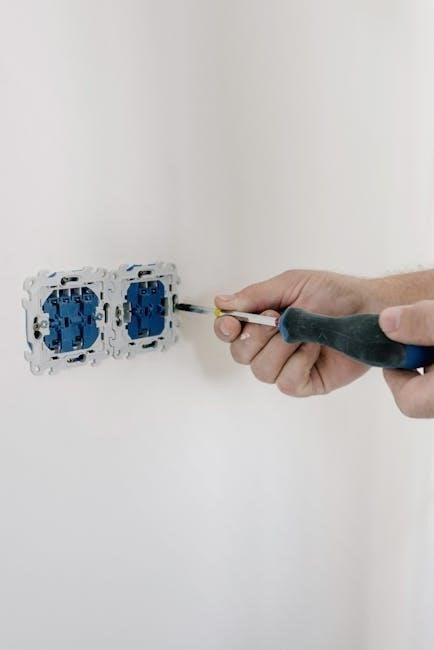The LiftMaster 8500 is a wall-mount garage door opener designed for safe and efficient operation. This guide provides step-by-step instructions for DIY installation on a balanced door, ensuring proper setup and functionality.
1.1 Understanding the LiftMaster 8500 Model
The LiftMaster 8500 is a wall-mount garage door opener designed for efficiency and durability. It features a powerful DC motor and advanced MyQ technology for smartphone connectivity. This model is ideal for homeowners seeking a space-saving solution, as it mounts directly on the wall, eliminating the need for overhead rails. Its sleek design and quiet operation make it a popular choice for modern garages. Understanding its features and compatibility is essential for a successful installation.
1;2 Importance of Proper Installation
Proper installation of the LiftMaster 8500 is critical for safety, functionality, and longevity. Incorrect installation can lead to safety hazards, including severe injury or death, especially if the door isn’t balanced or lubricated. A well-executed setup ensures smooth operation, prevents wear and tear on the door and opener, and guarantees compatibility with your garage door system. Always follow the manufacturer’s guidelines to avoid risks and ensure reliable performance over time.
Pre-Installation Requirements
Before starting, ensure your garage door is balanced and lubricated. Verify the installation area meets requirements for side clearance and ceiling height to guarantee safe and proper setup.
2.1 Assessing the Garage Door and Area
Evaluate the garage door and surrounding area to ensure compatibility. Check if the door is balanced and lubricated. Measure the clearance between the wall and torsion bar (minimum 2.5″) and ceiling (minimum 3″). Ensure the installation side allows proper operation. Verify the area is clear of obstructions. This assessment guarantees safe and proper installation of the LiftMaster 8500 opener, avoiding potential issues during operation.
2.2 Choosing the Correct Side for Installation
Selecting the correct side for the LiftMaster 8500 involves evaluating space and door mechanics. Ensure at least 2.5″ clearance between the wall and torsion bar, and 3″ from the ceiling. Consider the torsion springs’ location to maintain door balance. Check for obstructions like shelves or outlets. Choose a side with easy access to electricity. Aesthetics may influence your decision. Measure both sides to ensure compliance with manufacturer guidelines for a safe and functional installation.
2.3 Ensuring Safety and Compatibility
Before installation, ensure the garage door is properly balanced and lubricated to avoid accidents. Read the owner’s manual thoroughly for model-specific instructions. Verify compatibility with your door’s weight and size. Check for any obstructions that could interfere with the opener’s operation. Ensure the door is free from damage and functioning smoothly. Adhere to all safety guidelines and manufacturer recommendations to guarantee a secure and efficient installation process.

Tools and Materials Needed
Gather the necessary tools and materials, including a drill, wrenches, and ladder. Refer to the owner’s manual for specific requirements to ensure a smooth installation process.

3.1 List of Required Tools
The installation requires specific tools: a drill with bits, adjustable wrench, screwdrivers (Phillips and flathead), pliers, a ladder, and a measuring tape. Ensure all tools are readily available to streamline the process and avoid delays. Refer to the manual for any additional tools based on your garage door setup and opener model specifications.
3.2 Materials and Accessories
Essential materials include screws, bolts, brackets, cables, and the provided hardware kit. Accessories like a remote control, sensors, and a power door lock may be included. Additional items such as backup power systems or extra remotes can enhance functionality. Always refer to the owner’s manual for model-specific requirements to ensure all necessary components are available for a smooth installation process.

Step-by-Step Installation Process
The process involves mounting the opener, attaching the rail, and installing the emergency release. Follow detailed instructions for precise alignment and secure connections to ensure safety.
4.1 Positioning and Mounting the Opener
Proper positioning is crucial for smooth operation. Ensure the opener is installed on a side with at least 2.5″ clearance from the wall to the torsion bar and 3″ from the ceiling. Locate the header bracket above the garage door and center the opener for balanced operation. Secure the unit using provided wall brackets and bolts, ensuring tight alignment. Refer to the manual for precise measurements and hardware requirements. Double-check alignment before final tightening to avoid issues.
4.2 Attaching the Rail and Header Bracket
Begin by attaching the rail to the opener, ensuring proper alignment. Secure the header bracket to the wall above the garage door, maintaining the required 3″ clearance from the ceiling. Align the rail with the header bracket and connect them using the provided hardware. Tighten all bolts firmly to ensure stability. Double-check the alignment to prevent operational issues. Once connected, test the rail’s stability by gently tugging it to confirm it’s securely attached.
4.3 Installing the Emergency Release
Attach the emergency release handle to the trolley or rail as indicated in the manual. Ensure it’s easily accessible, typically at waist height. Secure the release rope to the handle and the door, ensuring it’s taut. Test by pulling the handle to disengage the door from the opener. Verify proper function and alignment for smooth operation. This feature allows manual door operation during power outages or system failures, ensuring safety and convenience.
Power and Door Lock Setup
Connect the opener to a grounded power source. Install the power door lock securely, ensuring proper alignment with the door. Test functionality and safety features.

5.1 Wiring and Power Connections
Connect the opener to a grounded 120V power source. Use the provided wiring harness to link components securely. Ensure all connections are tight and properly insulated. Avoid using extension cords. Install the power door lock by wiring it according to the manual. Test the system to confirm smooth operation. Refer to the user manual for specific wiring diagrams and troubleshooting tips to ensure safe and correct installation.
5.2 Installing the Power Door Lock

Attach the power door lock to the garage door following the manufacturer’s instructions. Ensure it aligns with the opener’s activation mechanism. Secure the lock firmly to prevent shifting. Connect the lock wiring to the opener’s control panel as specified. Test the lock by activating it with the remote or wall switch. Verify smooth engagement and disengagement. Consult the user manual for specific wiring and alignment details to ensure proper functionality and safety.

Testing and Adjustments
Test the LiftMaster 8500 opener to ensure smooth operation. Check the emergency release and force settings. Adjust the travel limits and sensitivity as needed for proper functionality and safety.
6.1 Initial Testing of the Opener
After installation, perform an initial test to ensure the opener functions correctly. Activate the opener and observe its smooth operation. Check that the door opens and closes fully without hesitation. Test the emergency release mechanism to confirm it disengages properly. Verify that all safety features, such as automatic reversal, are working as intended. If any issues arise, refer to the manual for troubleshooting or adjust settings as needed to ensure safe and reliable performance.

6.2 Adjusting Force and Travel Settings
Adjust the force and travel settings to ensure smooth operation. Start by checking the door’s balance and adjusting the opener’s force settings using the controls. Test the door’s movement, ensuring it opens and closes fully. If the door stalls or jerks, fine-tune the travel limits. Verify that the safety reversal feature works correctly by obstructing the door’s path during operation. Proper adjustments ensure safe, efficient, and reliable performance of your LiftMaster 8500 opener.
Maintenance and Troubleshooting
Regular maintenance ensures longevity and reliability of your LiftMaster 8500. Lubricate moving parts, inspect wires, and test safety features. Address common issues promptly to prevent malfunctions.
7.1 Routine Maintenance Tips
Regular maintenance is crucial for optimal performance. Lubricate the springs, rollers, and hinges every six months. Check and tighten all screws and bolts periodically. Ensure the rail is clean and free from obstructions. Test the emergency release handle monthly and verify door balance. Inspect the wire for damage or wear. Schedule professional inspection annually for advanced adjustments. Always refer to the user manual for specific maintenance recommendations tailored to the LiftMaster 8500 model.
7.2 Common Issues and Solutions
Common issues with the LiftMaster 8500 include misalignment of the rail, door imbalance, or wiring problems. If the opener stops working, check the power supply and connections. For door misalignment, adjust the sensors or realign the rail. Lubricate moving parts if noise increases. Consult the user manual for specific troubleshooting steps. If issues persist, contact a professional technician for advanced diagnostics and repairs to ensure safe and proper functionality of your garage door opener system.

Leave a Reply